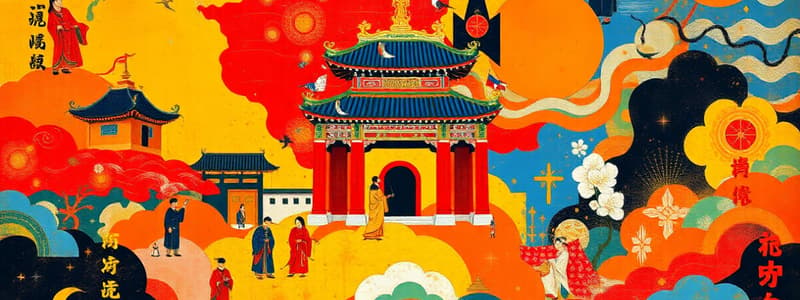Podcast
Questions and Answers
Which of the following scenarios best exemplifies a core tenet of the Bushido code?
Which of the following scenarios best exemplifies a core tenet of the Bushido code?
- A samurai who, despite disagreeing with his daimyo's policies, publicly supports them to maintain unity.
- A samurai who chooses ritual suicide (seppuku) after dishonoring himself, rather than living with shame. (correct)
- A samurai who meticulously plans a surprise attack, ensuring minimal losses for his own forces, regardless of the enemy's honor.
- A samurai who abandons his post to seek personal wealth and glory in a foreign land.
How did the economic policies of the Qing Dynasty primarily differ from those of the preceding Yuan Dynasty?
How did the economic policies of the Qing Dynasty primarily differ from those of the preceding Yuan Dynasty?
- The Qing Dynasty actively promoted maritime trade and exploration, while the Yuan Dynasty focused on internal commerce.
- The Qing Dynasty encouraged technological innovation and industrial development, while the Yuan Dynasty relied on agriculture.
- The Qing Dynasty emphasized agricultural self-sufficiency and limited foreign interaction, while the Yuan Dynasty fostered trade along the Silk Road. (correct)
- The Qing Dynasty implemented a centralized banking system, while the Yuan Dynasty relied on decentralized trade networks.
What was a key difference between the structure of the Ottoman and Safavid Empires?
What was a key difference between the structure of the Ottoman and Safavid Empires?
- The Ottoman Empire was led by a Caliph.
- The Safavid Empire was more focused on agriculture.
- The Safavid Empire had Janissaries.
- The Ottoman Empire followed Sunni Islam while the Safavid Empire followed Shiite Islam. (correct)
Which action taken by the Tokagawa Shogunate had the most far-reaching impact on Japan's subsequent development?
Which action taken by the Tokagawa Shogunate had the most far-reaching impact on Japan's subsequent development?
How did the role of the 'Gentry' in China differ from the role of 'Pashas' in the Ottoman Empire?
How did the role of the 'Gentry' in China differ from the role of 'Pashas' in the Ottoman Empire?
Flashcards
Silk Road
Silk Road
A trade route connecting East and West, facilitated by figures like Marco Polo.
Samurai
Samurai
A powerful warrior class in Japan, known for their swordsmanship and loyalty.
Bushido
Bushido
The code of honor and morals followed by the Samurai class in Japan.
Shogun
Shogun
Signup and view all the flashcards
Janissaries
Janissaries
Signup and view all the flashcards
Study Notes
China
- Confucius was a Chinese philosopher who wrote lawcodes.
- The Silk Road was a trade route run by Marco Polo.
- The Mongols were Genghis Khan's troops.
- Kubla Khan was the leader of the Yuan Dynasty and grandson of Genghis Khan.
- Kubla Khan created the Yuan Dynasty.
- Zhu Yuan Zhang led the Ming Dynasty.
- Zhu Yuan Zhang overthrew the Mongols.
- The Qing Dynasty had an agricultural-based economy and was uninterested in new technology.
- Qinlun accepted theoretical solutions to problems.
- Zhang He was a Chinese explorer who sailed for expeditions.
- Gentry acted as a Mayor for the Ottoman Empire.
Japan
- Shintoism is the primary religion.
- Miyamoto created the idea of a shogunate.
- Shogun is the highest position in the Japanese social class.
- Daimyo were large landowners, somewhat powerful, usually rich, and third in the social class.
- Samurai were warriors/swordsmen.
- Bushido is the Samurai code of honor.
- Oma Numanada created castle towns.
- Tokagawa did not allow lesser daimyo to become too powerful and put Japan in isolation.
- No one is allowed inside the Tokagawa Shogunate, which closed off Japan entirely.
West Asia
- Osmon led the Ottoman Empire.
- Janissaries were strong armies that mastered firearm technology.
- Sultan is the leader of the Sunnis.
- Pashas governed provinces in the Ottoman Empire.
- Suleman the Magnificent was identified as the ideal Islamic ruler.
- The Ottoman Empire has a Sultan/Sunnis.
- The Safavid Empire has a caliph/Shiites.
- The Mughal Empire was larger, richer, and more powerful than European kingdoms.
- Sha Abbas led the Safavid Empire within its peak.
- Akbar the Great was the leader of the Mughal Empire.
- Sepoy are outsiders who come to a town, hire townsfolk, and overthrow the town with their own townsfolk.
- Grand Vizier led the bureaucracy in the Ottoman Empire.
Studying That Suits You
Use AI to generate personalized quizzes and flashcards to suit your learning preferences.




